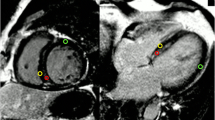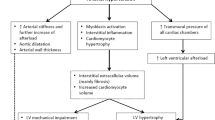Abstract
Hypertensive heart disease (HHD) causes structural changes (e.g., fibrosis) that result in diastolic and systolic myocardial dysfunction. Alterations of 31P metabolism and cardiac energy impairments were assessed in patients with HHD by MR spectroscopy (MRS) and correlated with left ventricular systolic function. Thirty-six patients with HHD and 20 healthy controls (mean age 35.2±10.7 years) were examined with 31P-MRS at 1.5 T by using an ECG-gated CSI sequence. Twenty-five patients (mean age 64.3±9.3 years) had diastolic dysfunction, but preserved systolic function (HHD-D), whereas 11 patients (62.3±11.4 years) suffered from additional impaired systolic function (HHD-S). In both patient groups, the PCr/γ-ATP ratio was lower than in the controls (controls: 2.07±0.17; P<0.001), and in HHD-S was lower than in HHD-D (1.43±0.21 vs. 1.65±0.25; P=0.012). PCr/γ-ATP ratios were linearly correlated with LVEF (Pearson's r: 0.39; P=0.025). In the HHD-S group, the PDE/γ-ATP ratio was significantly lower (0.56±0.36) than in the controls (1.14±0.42; P=0.001). In contrast to the group of HHD-D patients, whose slightly decreased PCr/γ-ATP ratios compared to controls may be explained by age differences, the more distinct changes observed in HHD-S patients indicate an altered energy metabolism. The observed metabolic changes were related to functional impairments, as indicated by a reduced LVEF. Reduced PDE/ATP ratios indicate changes in the phospholipid metabolism.



Similar content being viewed by others
References
Hennersdorf MG, Schannwell CM, Schwartzkopff B, Strauer BE (2003) Regression of left ventricular hypertrophy in hypertensive heart disease. Herz 28(8):764−778
Weber KT (2000) Targeting pathological remodeling: concepts of cardio-protection and reparation. Circulation 102:1342−1345
Weber KT (2001) Cardioreparation in hypertensive heart disease. Hypertension 38:588−591
Bottomley PA (1994) MR spectroscopy of the human heart: the status and the challenges. Radiology 191:593−612
Neubauer S, Horn M, Pabst T, Harre K, Stromer H, Bertsch G, Sandstede J, Ertl G, Hahn D, Kochsiek K (1997) Cardiac high-energy phosphate metabolism in patients with aortic valve disease assessed by 31P-magnetic resonance spectroscopy. J Investig Med 45:453−462
Ingwall JS, Kramer MF, Fifer MA, Lorell BH, Shemin R, Grossman W, Allen PD (1985) The creatine kinase system in normal and diseased human myocardium. N Engl J Med 24;313(17):1050−1054
Swain JL, Sabina RL, Peyton RB, Jones RN, Wechsler AS, Holmes EW (1982) Derangements in myocardial purine and pyrimidine nucleotide metabolism in patients with coronary artery disease and left ventricular hypertrophy. Proc Natl Acad Sci USA 79(2):655−659
Spindler M, Niebler R, Remkes H, Horn M, Lanz T, Neubauer S (2002) Mitochondrial creatine kinase is critically necessary for normal myocardial high-energy phosphate metabolism. Am J Physiol Heart Circ Physiol 283(2):H680−H687
Dzeja PP, Terzic A, Wieringa B (2004) Phosphotransfer dynamics in skeletal muscle from creatine kinase gene-deleted mice. Mol Cell Biochem 256-257(1-2):13−27
Miller DD, Walsh RA (1990-1991) In vivo phosphorus-31 NMR spectroscopy of abnormal myocardial high-energy phosphate metabolism during cardiac stress in hypertensive-hypertrophied non-human primates. Int J Card Imaging 6:57−70
Osbakken M, Douglas PS, Ivanics T, Zhang DN, Van Winkle T (1992) Creatinine kinase kinetics studied by phosphorus-31 nuclear magnetic resonance in a canine model of chronic hypertension-induced cardiac hypertrophy. J Am Coll Cardiol 19:223−228
Zhang J, Duncker DJ, Ya X, Zhang Y, Pavek T, Wei H, Merkle H, Ugurbil K, From AH, Bache RJ (1995) Effect of left ventricular hypertrophy secondary to chronic pressure overload on transmural myocardial 2-deoxyglucose uptake. A 31P NMR spectroscopic study. Circulation 92:1274−1283
Krahe T, Schindler R, Neubauer S, Ertl G, Horn M, Lackner K (1993) 31P-cardio-MR-spectroscopy in myocardial insufficiency. Rofo 159:64−70
Krahe T, Schindler R, Neubauer S, Hillenbrand H, Lackner K, Boesiger P, McKinnon G, Landwehr P, Ertl G (1991) In vivo 31P-cardiac magnetic resonance spectroscopy: methods and the first clinical results. Rofo 155:506−512
Schindler R, Krahe T, Neubauer S, Hillenbrand H, Entzeroth C, Horn M, Lackner K, Ertl G (1992) The direct measurement of the spin-grid-relaxation times of phosphorus metabolites in the human myocardium. Rofo 157:452−457
Beer M (2004) Cardiac spectroscopy: techniques, indications and clinical results. Eur Radiol 14(6):1034–1047
Neubauer S, Horn M, Cramer M, Harre K, Newell JB, Peters W, Pabst T, Ertl G, Hahn D, Ingwall JS, Kochsiek K (1997) Myocardial phosphocreatine-to-ATP ratio is a predictor of mortality in patients with dilated cardiomyopathy. Circulation 96:2190−2196
Löffler R, Sauter R, Kolem H, Haase A, von Kienlin M (1998) Localized spectroscopy from anatomically matched compartments: improved sensitivity and localization for cardiac 31P MRS in humans. J Magn Reson 134:287−299
Perings SM, Schulze K, Decking U, Kelm M, Strauer BE (2000) Age-related decline of PCr/ATP-ratio in progressively hypertrophied hearts of spontaneously hypertensive rats. Heart Vessels 15(4):197−202
Okada M, Mitsunami K, Inubushi T, Kinoshita M (1998) Influence of aging or left ventricular hypertrophy on the human heart: contents of phosphorus metabolites measured by 31P MRS. Magn Reson Med 39(5):772−782
Schocke MF, Metzler B, Wolf C, Steinboeck P, Kremser C, Pachinger O, Jaschke W, Lukas P (2003) Impact of aging on cardiac high-energy phosphate metabolism determined by phosphorus-31 2-dimensional chemical shift imaging (31P 2D CSI). Magn Reson Imaging 21(5):553−559
Beer M, Seyfarth T, Sandstede J, Landschutz W, Lipke C, Kostler H, von Kienlin M, Harre K, Hahn D, Neubauer S (2002) Absolute concentrations of high-energy phosphate metabolites in normal, hypertrophied, and failing human myocardium measured noninvasively with (31)P-SLOOP magnetic resonance spectroscopy. J Am Coll Cardiol 40(7):1267−1274
Lamb HJ, Beyerbacht HP, van der Laarse A, Stoel BC, Doornbos J, van der Wall EE, de Roos A (1999) Diastolic dysfunction in hypertensive heart disease is associated with altered myocardial metabolism. Circulation 99(17):2261−2267
Neubauer S, Krahe T, Schindler R, Horn M, Hillenbrand H, Entzeroth C, Mader H, Kromer EP, Riegger GA, Lackner K (1992) 31P magnetic resonance spectroscopy in dilated cardiomyopathy and coronary artery disease. Altered cardiac high-energy phosphate metabolism in heart failure. Circulation 86:1810−1818
Conway MA, Bottomley PA, Ouwerkerk R, Radda GK, Rajagopalan B (1998) Mitral regurgitation. Impaired systolic function, eccentric hypertrophy, and increased severity are linked to lower phosphocreatinine/ATP ratios in human. Circulation 97:1716−1723
Beer M, Spindler M, Sandstede J, Remmert H, Beer S, Kostler H, Hahn D (2004) Detection of myocardial infarctions by acquisition-weighted 31P-MR spectroscopy in humans. J Magn Reson Imaging 20:798−802
Auffermann W, Chew WM, Wolfe CL, Tavares NJ, Parmley WW, Semelka RC, Donnelly T, Chatterjee K, Higgins CB (1991) Normal and diffusely abnormal myocardium in humans: functional and metabolic characterization with P-31 MR spectroscopy and cine MR imaging. Radiology 179(1):253−259
Hansch A, Rzanny R, Heyne JP, Leder U, Reichenbach JR, Kaiser WA (2005) Noninvasive measurements of cardiac high-energy phosphate metabolites in dilated cardiomyopathy by using 31P spectroscopic chemical shift imaging. Eur Radiol 15(2):319−323
de Roos A, Doornbos J, Luyten PR, Oosterwaal LJ, van der Wall EE, den Hollander JA (1992) Cardiac metabolism in patients with dilated and hypertrophic cardiomyopathy: assessment with proton-decoupled P-31 MR spectroscopy. J Magn Reson Imaging 2(6):711−719
Jung WI, Sieverding L, Breuer J, Hoess T, Widmaier S, Schmidt O, Bunse M, van Erckelens F, Apitz J, Lutz O, Dietze GJ (1998) 31P NMR spectroscopy detects metabolic abnormalities in asymptomatic patients with hypertrophic cardiomyopathy. Circulation 97:2536−2542
Jung WI, Hoess T, Bunse M, Widmaier S, Sieverding L, Breuer J, Apitz J, Schmidt O, van Erckelens F, Dietze GJ, Lutz O (2000) Differences in cardiac energetics between patients with familial and nonfamilial hypertrophic cardiomyopathy. Circulation 28;101(12):E121
Schaefer S (1990) Clinical nuclear magnetic resonance spectroscopy: insight into metabolism. Am J Cardiol 26;66(14):45F−50F
Sakuma H, Takeda K, Tagami T, Nakagawa T, Okamoto S, Konishi T, Nakano T (1993) 31P MR spectroscopy in hypertrophic cardiomyopathy: comparison with Tl-201 myocardial perfusion imaging. Am Heart J 125(5 Pt 1):1323−1328
Wasser JS, Guthrie SS, Chari M (1997) In vitro tolerance to anoxia and ischemia in isolated hearts from hypoxia sensitive and hypoxia tolerant turtles. Comp Biochem Physiol A Physiol 118:1359−1370
Pucar D, Dzeja PP, Bast P, Gumina RJ, Drahl C, Lim L, Juranic N, Macura S, Terzic A (2004) Mapping hypoxia-induced bioenergetic rearrangements and metabolic signaling by 18O-assisted 31P NMR and 1H NMR spectroscopy. Mol Cell Biochem 256-257(1-2):281−289
Thebault MT, Kervarec N, Pichon R, Nonnotte G, Le Gal Y (2003) Distribution and potential role of cytosolic water-soluble phosphodiesters in fish. Physiol Biochem Zool 76(4):553−565
Choy PC, Tran K, Hatch GM, Kroeger EA (1997) Phospholipid metabolism in the mammalian heart. Prog Lipid Res 36(2-3):85−101
Hatch GM (2004) Cell biology of cardiac mitochondrial phospholipids. Biochem Cell Biol 82(1):99−112
Mrnka L, Novakova O, Pelouch V, Novak F (1996) Phospholipid composition in the rat heart exposed to pressure overload from birth. Physiol Res 45(1):83−85
Burt CT, Ribolow H (1994) Glycerol phosphorylcholine (GPC) and serine ethanolamine phosphodiester (SEP): evolutionary mirrored metabolites and their potential metabolic roles. Comp Biochem Physiol Biochem Mol Biol 108(1):11−20
Volpi E, Nazemi R, Fujita S (2004) Muscle tissue changes with aging. Curr Opin Clin Nutr Metab Care 7(4):405−410
Schunk K, Pitton M, Duber C, Kersjes W, Schadmand-Fischer S, Thelen M (1999) Dynamic phosphorus-31 magnetic resonance spectroscopy of the quadriceps muscle: effects of age and sex on spectroscopic results. Invest Radiol 34(2):116−125
Hancock CR, Brault JJ, Wiseman RW, Terjung RL, Meyer RA (2005) 31P-NMR observation of free ADP during fatiguing, repetitive contractions of murine skeletal muscle lacking AK1. Am J Physiol Cell Physiol 288(6):C1298−C1304
Zhang J, Merkle H, Hendrich K, Garwood M, From AH, Ugurbil K, Bache RJ (1993) Bioenergetic abnormalities associated with severe left ventricular hypertrophy. J Clin Invest 92(2):993−1003
Ingwall JS, Weiss RG (2004) Is the failing heart energy starved? On using chemical energy to support cardiac function. Circ Res 95(2):135−145
Acknowledgements
The authors acknowledge the excellent technical assistance of I. Krumbein and U. Jäger.
Author information
Authors and Affiliations
Corresponding author
Rights and permissions
About this article
Cite this article
Heyne, JP., Rzanny, R., Hansch, A. et al. 31P-MR spectroscopic imaging in hypertensive heart disease. Eur Radiol 16, 1796–1802 (2006). https://doi.org/10.1007/s00330-006-0170-0
Received:
Revised:
Accepted:
Published:
Issue Date:
DOI: https://doi.org/10.1007/s00330-006-0170-0




